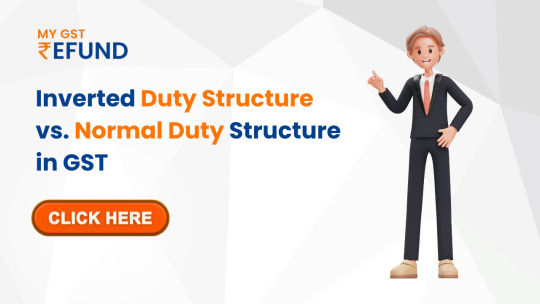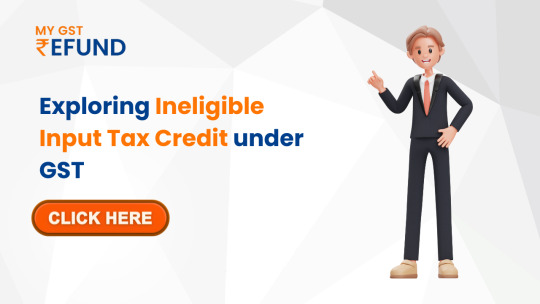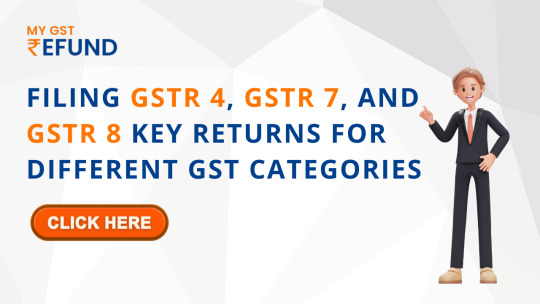ankitpathakspost
12 posts
Hi, I’m Ankit Pathak, and I had a great experience with MY GST Refund Consultant. Their team simplified the entire GST refund claim process, making it quick and stress-free. Thanks to their expert assistance, I received a GST refund without any issues. I recommend their services to any business owner who wants a smooth refund process.
Don't wanna be here? Send us removal request.
Text
Eligibility Criteria for Export Finance for Exporters

In today’s global economy, Indian exporters are playing a crucial role in driving growth and expanding international trade. However, navigating the complexities of international markets often requires more than just a competitive product or service — it demands strong financial support. This is where export finance comes into play. It offers vital liquidity to exporters, enabling them to fulfill overseas orders efficiently.
Before diving into the process of availing such financial support, it's important to understand the eligibility criteria for export finance for exporters. Whether you are a startup venturing into exports or a seasoned player aiming to scale, knowing the prerequisites can streamline your journey.
What is Export Finance?
Export finance refers to financial assistance provided to exporters before or after shipment to manage the working capital gap. It includes various forms such as pre-shipment finance, post-shipment finance, packing credit, and bills discounting.
To learn more about our Export Finance Service tailored to Indian exporters, you can explore our solutions that ensure seamless funding and documentation support.
Key Eligibility Criteria for Export Finance
Banks and financial institutions have set several benchmarks to determine an exporter’s eligibility. Here are the major criteria:
1. Exporter Registration
The applicant must be a registered exporter with a valid Importer Exporter Code (IEC) issued by the Director General of Foreign Trade (DGFT). This is the primary identification for any Indian entity engaging in cross-border trade.
2. Proof of Export Orders
Exporters must furnish confirmed export orders or letters of credit (LCs) from international buyers. These documents serve as proof of pending payments and validate the requirement for financial assistance.
3. Business Vintage and Financial Stability
Although startups are not excluded, having at least 1–2 years of business operations and a healthy financial track record increases your chances of approval. Institutions assess balance sheets, turnover, and profit margins as part of risk evaluation.
4. KYC and Compliance Documents
Exporters must submit complete Know Your Customer (KYC) documents, including:
Company PAN and GSTIN
Address proof
Bank statements
Ownership details
Compliance with anti-money laundering laws and FEMA regulations is essential.
5. Satisfactory Credit Rating
Banks and NBFCs consider the creditworthiness of an exporter. A good credit rating and repayment history with other lenders enhance your eligibility. Some institutions might also consider CIBIL scores for individual proprietors or directors.
6. Nature of Goods Exported
Certain goods such as arms, wildlife, and restricted chemicals are subject to additional scrutiny. Exporters dealing in sensitive or banned items are typically excluded from financing schemes.
7. Collateral and Guarantees
Depending on the financial institution and type of finance (secured vs. unsecured), exporters might be asked to provide collateral or personal guarantees. Government schemes such as ECGC (Export Credit Guarantee Corporation) help mitigate risk for lenders.
Why Export Finance is Critical
Export finance helps bridge the gap between shipment and payment receipt, ensuring that exporters don’t face liquidity issues. It also allows you to accept larger orders without disrupting working capital for domestic operations.
Our Export Finance Service is designed to offer fast approvals, competitive rates, and full compliance support to MSMEs and large exporters alike.
Don’t Miss Out on GST Refunds
In addition to funding, exporters are eligible for GST Refund on the goods and services exported. Timely refunds improve your cash flow and reduce the burden of indirect taxes. If you’re looking to streamline this process, explore our specialized Export GST Refund Service, which ensures accurate filings, timely submissions, and end-to-end compliance with minimal manual intervention.
Conclusion
Securing export finance can be a game-changer for Indian exporters aiming to thrive in international markets. By meeting the eligibility criteria and staying compliant, exporters can unlock growth opportunities and meet global demand without financial stress. Whether you need capital to fulfill a large order or want to claim your export GST refund efficiently, professional support can make all the difference. Looking to get started? Check out our Export Finance Service and Export GST Refund Service to boost your export journey today.
0 notes
Text
Impact of Inverted Duty Structure on Indian Manufacturers

The Goods and Services Tax (GST) system in India was introduced to simplify the indirect taxation landscape and encourage ease of doing business. However, certain structural inefficiencies still persist, one of the most notable being the Inverted Duty Structure (IDS). This occurs when the rate of tax on input goods or services is higher than the rate on the final product, leading to excess unutilized input tax credit (ITC).
While the government allows refunds under IDS in certain cases, the impact on Indian manufacturers has been significant—particularly on small and medium enterprises. In this article, we will explore the challenges Indian manufacturers face due to IDS and how it affects their operations, competitiveness, and long-term growth.
1. Working Capital Crunch
One of the biggest challenges IDS poses is a blockage of working capital. When manufacturers pay a higher GST on raw materials than they collect on final goods, they accumulate ITC.
Although refunds are permitted under Section 54(3) of the CGST Act, they are often delayed or involve cumbersome paperwork. This delay in receiving refunds reduces liquidity, particularly hurting small manufacturers that run on tight margins.
2. Reduced Profitability
The accumulation of unutilized ITC leads to cost inefficiencies. While theoretically refundable, the time lag and administrative hassles mean that manufacturers effectively incur a higher cost of production.
In price-sensitive markets like textiles, fertilizers, or footwear, manufacturers often can't pass these additional costs to consumers. This shrinks their margins and limits reinvestment into business expansion, innovation, or product quality.
3. Competitive Disadvantage
Indian manufacturers facing IDS often find themselves at a disadvantage compared to foreign competitors, especially those importing under Free Trade Agreements (FTAs). Imported goods may come with lower or zero duties, while domestic producers pay higher taxes on inputs.
This defeats the goal of Make in India and undermines domestic industry, as local manufacturers lose their competitive pricing edge in both domestic and global markets.
4. Operational Inefficiencies and Compliance Burden
Claiming refunds under IDS involves detailed documentation, reconciliation, and adherence to strict timelines. This creates an administrative burden, especially for small businesses with limited resources.
Manufacturers often have to dedicate manpower and systems just to track GST input/output mismatches, adding to their overhead costs and reducing operational efficiency.
5. Sectoral Stress
Certain sectors are disproportionately affected by IDS:
Textiles: Input taxed at 12%/18%, output at 5%.
Footwear: Input at 18%, low-cost output at 5%.
Fertilizers: Inputs at 18%, output at 5%.
Pharmaceuticals: Inputs at 18%, life-saving drugs at 5% or exempt.
These sectors employ millions of workers, many in rural or semi-urban areas. When profitability and competitiveness decline due to IDS, it can lead to job losses, lower wages, and reduced economic activity in these regions.
6. Disincentive to Expand Production
A persistent IDS acts as a disincentive to scale operations. Manufacturers hesitate to invest in increasing production capacities when returns are uncertain due to unresolved tax credits and refunds.
This also impacts India’s manufacturing growth targets and hinders industrial development, especially in key export sectors.
7. Impact on GST Compliance and Trust
Frequent refund delays, rejections, and complex procedures erode trust in the GST system. Manufacturers may begin to underreport or manipulate inputs to avoid accumulation, which increases the risk of tax evasion and further complicates the compliance ecosystem.
Steps Taken by the Government
The GST Council has acknowledged the problem and taken some steps, such as:
Changing GST rates to reduce input-output tax mismatch.
Allowing IDS refunds under Rule 89(5) for specified goods.
Proposing rate rationalization to simplify the structure.
However, much remains to be done, especially in fast-growing sectors still burdened by IDS.
If you want to claim an Inverted Duty GST refund, connect with the MYGST Refund team, who will assist you from filing the application to receiving the refund in your bank account
Conclusion
The Inverted Duty Structure, while seemingly a technical tax anomaly, has serious real-world implications for Indian manufacturers. From cash flow issues to competitiveness concerns, the impact is far-reaching.
For India to become a true global manufacturing hub, resolving IDS and simplifying refund mechanisms must be a priority. A rationalized GST rate structure that aligns inputs and outputs will empower Indian manufacturers to grow, compete, and contribute meaningfully to the country’s economic development.
0 notes
Text
Exploring Ineligible Input Tax Credit under GST

While GST allows for the claim of ITC on various inputs, certain goods and services are specifically excluded under Section 17(5) of the CGST Act. These exclusions are designed to prevent misuse and ensure that the credit mechanism is used for Eligible and Ineligible Input Tax Credits under GST.
Common Ineligible ITC Items
The following items are generally ineligible for ITC:
Motor Vehicles: ITC on motor vehicles is restricted unless they are used for specific purposes such as further supply, transportation of passengers, or imparting training.
Food and Beverages: ITC on food, beverages, and outdoor catering services is not allowed unless they are used for making an outward taxable supply of the same category of goods or services.
Claim your Export GST Refund hassle-free! Contact us now for expert guidance, quick processing, and maximizing your GST refund. Don’t wait—Request a Callback today!
Health and Fitness Services: Expenses related to health services, cosmetic and plastic surgery, and membership of clubs and health and fitness centers are ineligible unless they are obligatory for an employer to provide to its employees under any law.
Construction of Immovable Property: ITC is not available for goods and services used for the construction of immovable property, other than plant and machinery, unless it is used for further supply of the same.
Personal Consumption: Goods and services used for personal consumption are not eligible for ITC.
Conclusion
Understanding these exclusions is crucial for businesses to avoid claiming ineligible ITC, which can lead to penalties and interest. It's essential to maintain proper records and ensure that only eligible inputs are considered for ITC claims.
FAQs
Can ITC be claimed on motor vehicles?
ITC on motor vehicles is restricted unless they are used for specific purposes such as further supply, transportation of passengers, or imparting training.
Is ITC available on food and beverages?
ITC on food, beverages, and outdoor catering services is not allowed unless they are used for making an outward taxable supply of the same category of goods or services.
Can ITC be claimed on health and fitness services?
Expenses related to health services, cosmetic and plastic surgery, and membership of clubs and health and fitness centers are ineligible unless they are obligatory for an employer to provide to its employees under any law.
Is ITC available for construction of immovable property?
ITC is not available for goods and services used for the construction of immovable property, other than plant and machinery, unless it is used for further supply of the same.
Can ITC be claimed for personal consumption?
0 notes
Text
GST Refund Process for Exporters: Key Things You Should Know

Exporters play a vital role in the Indian economy, and under the GST regime, they are provided with a special refund mechanism. If you're an exporter, it’s crucial to understand how the GST refund process works for you. This post will guide you through the key steps and things you should know when claiming GST refunds.
Zero-Rated Exports
One of the most important aspects of GST for exporters is that exports are zero-rated, meaning goods or services sold abroad are exempt from GST. However, exporters still pay GST on their inputs—raw materials, services, and capital goods—used to produce or deliver the exported goods or services.
Since there’s no output tax on exports, businesses cannot set off the input tax against output GST, which is why they are eligible to claim GST a Refund of the tax paid on their inputs.
Documents Required for Refund
To claim Export GST Refund, exporters must provide the necessary documentation. Some of the key documents include:
Export invoices showing the GST paid on inputs.
Shipping bills to prove that the goods have been exported.
Bank account details to receive the refund.
Proof of payment of GST on inputs.
These documents are required to validate the refund claim and ensure compliance with GST rules.
Filing the Refund Application
Exporters can apply for GST refunds via the GST portal. The process involves filing Form RFD-01 for refund claims. This form needs to be filled out with details of the export transactions, GST paid on inputs, and any other necessary supporting documents.
Once the application is submitted, it will be reviewed by GST authorities for accuracy and completeness. In most cases, exporters are required to file a GST return before submitting the refund application to ensure compliance.
Challenges Exporters Face
Although GST refunds for exporters are beneficial, they sometimes face challenges such as delays in processing, rejection of claims, or a mismatch of data. Here are a few common issues:
Delayed refunds: Refunds may take up to 60 days to be processed.
Rejection of claims: Incomplete or incorrect documentation can lead to rejection.
Mismatch of data: Discrepancies between GST returns and export details can result in delays.
Conclusion
Exporters have a unique advantage under the GST system—refunds for the GST paid on inputs. By following the proper procedures, maintaining documentation, and being aware of the challenges, exporters can successfully claim their GST refunds and improve cash flow. Always consult a tax professional to ensure smooth processing of your refund claims.
0 notes
Text
Reverse Charge Mechanism (RCM) in Goods and Services Tax (GST)

The Goods and Services Tax (GST) has significantly simplified the indirect tax structure in India. However, one concept under GST that often confuses businesses is the Reverse Charge Mechanism (RCM). Unlike the usual tax payment system where the supplier collects and remits the tax, RCM flips the responsibility, making the recipient of goods or services liable to pay GST directly to the government.
In this blog, we'll explore what RCM is, when it applies, key provisions, compliance requirements, and practical examples to help you understand its real-world impact.
What is Reverse Charge Mechanism (RCM)?
Under the Reverse Charge Mechanism, the liability to pay tax shifts from the supplier to the recipient of goods or services. This mechanism is primarily designed to bring unregistered suppliers, imported services, and certain notified categories under the tax net.
Legal Provisions for RCM in GST
RCM is governed by the following sections of the CGST Act, 2017:
Section 9(3): Tax is payable on notified goods and services by the recipient.
Section 9(4): Tax is payable by a registered person on goods/services received from an unregistered supplier, subject to certain conditions and exemptions.
Section 5(3) and 5(4) of the IGST Act: These deal with inter-state supplies and mirror the provisions of Section 9 of the CGST Act.
Types of Reverse Charge in GST
1. RCM on Notified Goods and Services (Section 9(3))
The government, on the recommendation of the GST Council, has notified specific categories of goods and services where RCM is applicable. Some examples include:
2. RCM on Supply from Unregistered Suppliers (Section 9(4))
This provision initially created a lot of compliance burden and was suspended for a while. Currently, RCM under Section 9(4) applies only in certain cases like:
Inward supplies received by promoters and builders for construction purposes.
Certain procurement by government entities or PSUs from unregistered suppliers.
Input Tax Credit (ITC) under RCM
Yes, the recipient who pays tax under RCM is eligible to claim Input Tax Credit (ITC), provided the goods/services are used for business purposes. However:
The ITC can only be claimed after the tax is paid.
Proper documentation (like self-invoice and payment proof) must be maintained.
Compliance Requirements under RCM
Self-Invoicing: If goods/services are received from an unregistered dealer, the recipient must issue an invoice on their behalf.
Payment Vouchers: A payment voucher must be issued at the time of making payment.
Monthly GST Returns (GSTR-3B): RCM liabilities must be disclosed and paid in cash (ITC cannot be used for this payment).
GSTR-1: Though not required for outward supplies under RCM, inward supplies under RCM should be maintained accurately.
Examples of Reverse Charge Mechanism
Example 1:
A company avails legal services from an individual advocate. Since the advocate is not liable to collect GST, the company must pay GST under RCM and then claim ITC.
Example 2:
A registered builder purchases cement from a local unregistered dealer. The builder must pay GST on this supply under Section 9(4) and can claim ITC if used for taxable output supplies.
Penalties for Non-Compliance with RCM
Failure to comply with RCM provisions can result in:
Interest on unpaid tax (currently 18% p.a.),
Penalties under Sections 73 or 74 of the CGST Act,
Potential loss of ITC for non-payment or incorrect reporting.
Latest Updates on RCM (As of 2025)
RCM continues to be an evolving area with frequent notifications.
Recent updates include changes in RCM applicability for e-commerce operators, expanded GTA rules, and clarifications for real estate sector.
For the most recent changes, refer to GST Portal or consult a tax professional.
Read More: Documents Checklist Required for GST Registration
Conclusion
The Reverse Charge Mechanism under GST plays a crucial role in ensuring tax compliance, especially where suppliers are not registered or are located outside India. Though it adds a layer of responsibility for the recipient, understanding the rules, timelines, and documentation requirements can help businesses stay compliant and optimize their Input Tax Credit.
If you deal with any categories under RCM, it's essential to maintain proper records, stay updated on notifications, and ensure timely payment and reporting of tax.
0 notes
Text
Top 5 Benefits of GST Registration for Small and Medium Enterprises (SMEs)

Implementing the Goods and Services Tax (GST) in India has significantly transformed the taxation landscape, offering numerous advantages to businesses across various sectors. For Small and Medium Enterprises (SMEs), GST registration presents several key benefits that can enhance operational efficiency, expand market reach, and improve financial management.
1. Access to Input Tax Credit (ITC)
GST registration allows SMEs to claim Input Tax Credit on taxes paid for business-related purchases. This mechanism enables businesses to offset the GST paid on inputs against the GST collected on sales, effectively reducing the overall tax liability. By minimizing the cascading effect of taxes, SMEs can lower operational costs and improve profit margins.
2. Simplified Compliance and Reduced Tax Burden
Prior to GST, businesses navigated a complex web of state and central taxes, each with its own compliance requirements. GST consolidates multiple taxes into a single, unified system, streamlining compliance processes. SMEs benefit from simplified procedures, including online registration, return filing, and tax payments, reducing the administrative burden and associated costs.
3. Enhanced Credibility and Business Opportunities
GST registration enhances a business's credibility by demonstrating compliance with national tax standards. This improved reputation can attract more customers, suppliers, and investors. Moreover, many large enterprises prefer dealing with GST-registered SMEs to avail input tax credits, opening up new business opportunities and potential partnerships.
4. Facilitation of Interstate Trade
Before GST, varying tax rates across states created barriers to interstate commerce. GST has standardized tax rates nationwide, simplifying the movement of goods and services across state lines. For SMEs, this means easier expansion into new markets, reduced logistics costs, and the ability to compete more effectively on a national scale.
finacbooks.com
5. Eligibility for Composition Scheme
GST offers a Composition Scheme for small businesses with an annual turnover below a specified threshold. This scheme allows SMEs to pay tax at a reduced rate on turnover, simplifying tax compliance and reducing the tax burden. It provides a cost-effective option for small businesses to operate under the GST regime while focusing on growth and expansion.
6. Improved Access to Financial Services
GST registration enhances a business's financial credibility, making it easier to access formal credit facilities. Financial institutions view GST-registered businesses as more reliable due to their adherence to tax regulations, potentially leading to better loan terms and increased investment opportunities.
7. Participation in Government Tenders
Many government tenders and contracts require bidders to be GST-registered. GST registration opens up opportunities for SMEs to participate in government projects, which can lead to steady revenue streams and long-term business growth.
finacbooks.com
8. Legal Protection and Avoidance of Penalties
GST registration ensures that businesses comply with tax laws, protecting them from legal issues and penalties associated with non-compliance. This legal safeguard contributes to smooth operations and a positive business reputation.
9. Better Credit Rating
Financial institutions often consider GST registration as a positive factor while assessing the creditworthiness of businesses. It reflects a commitment to transparency and compliance, potentially leading to better loan terms and access to financing options.
Ardhorajiya
10. Facilitation of Government Contracts
Government tenders and contracts often require vendors to be GST-registered. By fulfilling this criterion, your business becomes eligible to participate in lucrative government projects, opening avenues for steady revenue streams and long-term partnerships with government entities.
Read More: Complete Guide to GST Registration: Eligibility, Fees, and Compliance
Frequently Asked Questions (FAQs)
Is GST registration mandatory for all SMEs?
No, GST registration is mandatory for SMEs exceeding the turnover threshold or engaged in specific activities like interstate trade.
What is the threshold limit for GST registration for SMEs?
For goods: ₹40 lakhs (₹20 lakhs for special category states). For services: ₹20 lakhs (₹10 lakhs for special category states).
Can GST-registered SMEs operate in multiple states?
Yes, GST registration facilitates interstate trade, allowing SMEs to operate across India with a unified tax system.
How does GST registration enhance an SME's credibility?
GST registration signifies compliance with national tax regulations, building trust among customers, suppliers, and investors.
Are there any benefits for SMEs under GST apart from the ones mentioned above?
Yes, GST registration also provides benefits like eligibility to participate in government tenders, simplified tax compliance, and access to a wider customer base.
Conclusion
GST registration offers SMEs a host of benefits, from financial advantages like input tax credits and reduced tax burdens to operational improvements through simplified compliance and expanded market access. By embracing GST, SMEs can enhance their competitiveness, credibility, and growth prospects in an increasingly dynamic business environment.
0 notes
Text

🚨𝗟𝗮𝘀𝘁 𝗖𝗵𝗮𝗻𝗰𝗲! 𝗗𝗼𝗻’𝘁 𝗠𝗶𝘀𝘀 𝗢𝘂𝘁 𝗼𝗻 𝘁𝗵𝗲 𝗚𝗦𝗧 𝗥𝗲𝗳𝘂𝗻𝗱 & 𝗔𝘂𝘁𝗼𝗺𝗮𝘁𝗶𝗼𝗻 𝗠𝗮𝘀𝘁𝗲𝗿𝗰𝗹𝗮𝘀𝘀!🚨
Join our 𝗚𝗦𝗧 𝗥𝗲𝗳𝘂𝗻𝗱 𝗠𝗮𝘀𝘁𝗲𝗿𝗰𝗹𝗮𝘀𝘀 with expert 𝗞𝗮𝗽𝗶𝗹 𝗠𝗮𝗵𝗮𝗻𝗶 and gain hands-on experience in GST refunds.
✅ Free tools worth ₹10K ✅ Certification & Live Q&A 📅 22-23 March 2025 | ⏰ 6:00 PM
𝗦𝘁𝗶𝗹𝗹 𝗛𝗮𝘃𝗲𝗻'𝘁 𝗥𝗲𝗴𝗶𝘀𝘁𝗲𝗿𝗲𝗱? 𝗟𝗶𝗺𝗶𝘁𝗲𝗱 𝘀𝗲𝗮𝘁𝘀! 𝗥𝗲𝗴𝗶𝘀𝘁𝗲𝗿 𝗡𝗼𝘄:https://www.mygstrefund.com/live-course/
0 notes
Text
How the Duty Drawback Scheme Can Boost Your Export Business

In today’s competitive global marketplace, finding ways to reduce costs while maintaining quality and efficiency is essential for success. One of the most valuable tools available to exporters is the Duty Drawback Scheme. This program allows businesses to recover duties paid on goods that are imported but ultimately exported. Here's how the Duty Drawback Scheme can significantly boost your export business:
1. Cost Savings
One of the primary advantages of the Duty Drawback Scheme is the opportunity to reclaim duties and taxes paid on imported materials or components that are used in manufacturing products for export. This reduces the overall cost of production, allowing exporters to improve their profit margins. The lower cost structure means that businesses can offer more competitive pricing on their products in international markets, attracting more customers and increasing their sales potential.
2. Increased Competitiveness
When you can lower the costs of your goods through the Duty Drawback Scheme, you gain a competitive edge over other players in the market. Exporting businesses can offer their products at more attractive prices, making them more appealing to foreign buyers. This helps you expand your market share and reach new customers in different regions.
3. Improved Cash Flow
The Duty Drawback Scheme also provides a boost to cash flow. Refunds are typically processed relatively quickly, providing businesses with additional liquidity. These funds can be reinvested into the business, helping to fund new initiatives, improve operations, or even cover day-to-day expenses.
4. Encourages Export Growth
The scheme incentivizes businesses to focus on international markets by alleviating some of the financial burdens associated with imports. This makes it easier for companies to scale up their export operations and diversify their product range. As a result, more businesses are encouraged to explore global opportunities, which is crucial for long-term success. In summary, the Duty Drawback Scheme is an excellent way for exporters to save on costs, enhance competitiveness, and improve cash flow. By leveraging this scheme, businesses can position themselves for growth and success in the global marketplace.
0 notes
Text
GST Refund for Manufacturers: How Inverted Duty Structure Impacts Your Business

The Goods and Services Tax (GST) system, introduced in India in 2017, was designed to streamline indirect taxation and foster business growth by providing a single tax structure across the country. However, manufacturers operating under this system face unique challenges, especially in cases involving the "Inverted Duty Structure" (IDS). This structure can significantly impact cash flow, operational efficiency, and overall business sustainability. Understanding how IDS works and how GST refunds apply to it is crucial for manufacturers to avoid financial strain.
What is Inverted Duty Structure (IDS)?
The Inverted Duty Structure occurs when the tax rate on inputs (raw materials and intermediate goods) is higher than the tax rate on finished goods or output. In simpler terms, a manufacturer is paying more GST on the raw materials they purchase than they are collecting on the products they sell.
For instance, if a manufacturer is dealing with products taxed at 18% GST but their inputs are taxed at 28%, they face an imbalance. They pay more GST on their inputs than they can collect from customers on the final product, leading to an accumulation of excess tax paid.
How Does Inverted Duty Structure Affect Manufacturers?
Cash Flow Problems
One of the most significant challenges posed by IDS is the impact on a manufacturer’s cash flow. When input tax exceeds output tax, manufacturers are effectively out of pocket for the excess GST. This leads to an increase in working capital requirements, as the business needs to bear the cost of the tax differential. The excess tax paid cannot be claimed immediately unless a refund is processed, which can take time.
Increased Operational Costs
Because of IDS, manufacturers may need to absorb the higher input tax cost, potentially affecting their pricing strategies. If a business cannot pass on the extra cost to customers due to price sensitivity or market conditions, their profit margins may shrink.
Inventory Management Challenges
The IDS system creates complexities in inventory management. Manufacturers may have to manage a larger stock of goods and raw materials to optimize the GST refunds, which can lead to additional holding costs. With the surplus tax input, managing large inventories could become cumbersome and financially draining.
The Role of GST Refund for Manufacturers
GST provides manufacturers with a mechanism to reclaim the excess tax paid on inputs under the inverted duty structure. The tax paid on inputs that exceeds the output tax liability can be claimed back as a refund. This process is crucial for manufacturers as it helps restore liquidity and allows for smoother operations.
Here’s a step-by-step breakdown of how the GST refund process works for manufacturers:
Eligibility for Refund
Manufacturers can claim refunds under IDS if the rate of tax on inputs is higher than the rate of tax on output supplies. To be eligible, the manufacturer must be registered under GST and need to maintain proper documentation showing the tax paid on inputs versus the tax collected on outputs.
Refund Process
The GST refund application must be filed online via the GST portal. Manufacturers are required to fill out the necessary forms, such as GST RFD-01, and provide supporting documents such as invoices for the purchase of inputs and sales. Additionally, the business needs to demonstrate that they are not passing on the excess tax burden to customers through pricing strategies.
Timeframe for Refund
The process for GST refunds can be time-consuming. Once an application is submitted, the refund is typically processed within 60 days, though it may take longer in some cases. Manufacturers should plan for this delay in their financial operations, as cash flow could be affected during the waiting period.
Refund Rejection
Refund applications can be rejected if the documents submitted are not in order or if the excess input tax credit is not verifiable. Additionally, if the tax paid on inputs is found to be unjustified or the manufacturer has not complied with all GST regulations, the refund request could be denied.
Navigating the Challenges
While the GST refund process provides relief to manufacturers, it also poses several challenges:
Compliance: Ensuring accurate and timely documentation is critical. Manufacturers should invest in robust accounting systems or partner with experts who understand GST intricacies.
Improving Efficiency: To avoid the build-up of excess tax, manufacturers can consider strategies like optimizing the procurement of inputs or exploring tax planning opportunities, such as availing tax credit for capital goods.
Policy Advocacy: Manufacturers can engage with industry bodies to advocate for reforms in the inverted duty structure, aiming for a more balanced tax system that supports business growth.
Conclusion
The inverted duty structure under GST can have a significant impact on manufacturers, especially in terms of cash flow and working capital. While the GST refund mechanism offers a solution to reclaim the excess tax paid on inputs, the process can be complicated and time-consuming. To mitigate these challenges, manufacturers must ensure compliance, optimize their supply chains, and actively engage with policy discussions around GST reforms. By doing so, they can not only manage the financial implications of IDS but also enhance their long-term profitability and sustainability in a competitive market environment.
0 notes
Text

GST Refund Under Inverted Duty: Understanding the Process & Eligibility
GST refund under an Inverted duty structure allows businesses to claim refunds on the excess tax paid on inputs over outputs. This situation arises when the GST rate on inputs is higher than on final goods or services. Learn about the eligibility, documentation, and refund process to optimize your business’s cash flow and ensure compliance.
0 notes
Text
Common Pitfalls to Avoid When Claiming GST Refund for Exports

Claiming a GST refund for exports can provide essential relief to businesses facing the burden of excess Input Tax Credit (ITC) due to the Inverted Duty Structure (IDS). However, the refund process can be complex and time-consuming. Many exporters make common mistakes that delay or even result in the rejection of their refund claims. To ensure that you successfully claim your GST refund, it's essential to understand and avoid these pitfalls.
In this blog, we will explore some of the common mistakes exporters make when claiming GST refunds and how to avoid them, ensuring a smooth and hassle-free process.
Also Read: GST Refund Claim Process
1. Incomplete or Incorrect Documentation
One of the most common reasons for refund rejections is incomplete or inaccurate documentation. Exporters often fail to submit the correct documents or fail to match the details across various records. For example, if the export invoices, purchase invoices, or bills of entry are missing or don’t align with the data submitted in GST returns, the tax authorities may reject the refund application.
How to Avoid:
Ensure all required documents (export invoices, purchase invoices, export bills of entry, and proof of tax paid) are accurate and complete.
Cross-check that the information in your GSTR-1 (outward supplies) and GSTR-3B (summary of returns) matches the supporting documents.
Keep a record of all tax-paid purchases and export details for easy reference.
2. Mismatched Data Between GSTR-1 and GSTR-3B
A mismatch in data between the GST returns (GSTR-1 and GSTR-3B) is a frequent pitfall that can lead to rejection or delays in refund claims. This mismatch often occurs when the details of export transactions, ITC claims, or output tax reported in the returns don’t match the actual invoices or purchase transactions.
How to Avoid:
Double-check that the data reported in your GST returns matches your invoices and export bills.
Ensure that the ITC claimed is supported by proper tax invoices and consistent with the return filed.
Reconcile the details in GSTR-1 and GSTR-3B before submitting your refund application.
Recommended:GST Refund for Exporters
3. Failure to Meet Eligibility Criteria
To be eligible for claiming a GST refund for exports, your business must meet specific criteria, such as exporting goods or services and having unutilized ITC due to the inverted duty structure. Sometimes exporters may unknowingly submit claims without fully understanding the eligibility requirements, which can result in rejection.
How to Avoid:
Review the eligibility criteria before filing a refund claim. Ensure that your exports are zero-rated and you have excess ITC that cannot be utilized due to the inverted duty structure.
Confirm that all necessary GST returns have been filed and paid on time to be eligible for a refund.
4. Missing the Deadline for Filing Refund Application
Another common issue exporters face is missing the deadline for filing a refund application. GST law imposes a time limit for claiming refunds, which, if missed, can result in a permanent loss of the credit. The general timeline for claiming a GST refund is within two years from the end of the financial year in which the refund arose.
How to Avoid:
Mark the deadline for refund claims and ensure timely submission.
Set reminders to keep track of deadlines, especially if you’re dealing with multiple refund claims.
If you miss the deadline, consider reaching out to a GST consultant to explore any alternative solutions.
5. Incorrect or Incomplete Bank Account Details
When you submit your refund application, you need to provide your bank account details to receive the refund amount. Inaccurate or incomplete bank information can cause delays or prevent the refund from being credited to your account.
How to Avoid:
Ensure that your bank account details are accurate, including the IFSC code, account number, and bank branch details.
Double-check that the bank account is linked to your GST registration and matches the details provided in the GST portal.
6. Ignoring Exporter’s Monthly Compliance
Claiming a refund for exports requires you to have filed your monthly GST returns properly. If your monthly compliance (filing GSTR-1 and GSTR-3B) is not up to date, your refund application will likely be delayed or rejected.
How to Avoid:
Keep track of your monthly GST returns and file them on time.
Verify the information in your monthly returns to ensure accuracy and consistency.
Maintain proper records of exports and input purchases for easy reference when filing returns.
7. Overclaiming ITC or Refund Amount
Some exporters may unintentionally overclaim ITC or the refund amount due to incorrect calculations. For instance, claiming a higher amount of input tax credit than what was actually paid or applying for a refund on ineligible items can lead to audit scrutiny or rejection.
How to Avoid:
Accurately calculate the ITC available and ensure that it corresponds with the taxes paid on your input goods or services.
Cross-verify the refund claim against the eligible ITC to ensure the claim is reasonable.
Use tools like GST Refund calculators to assist in determining the exact refund amount you are entitled to.
8. Not Consulting a GST Expert
The refund process can be tricky, and many exporters may overlook nuances or legal complexities. Lack of professional guidance can lead to mistakes that result in delays or rejections of claims.
How to Avoid:
Consider consulting a GST expert or tax professional who can guide you through the refund process.
An expert can help you avoid common mistakes and ensure that you comply with all legal requirements and deadlines.
Also Read: GST Litigation Services
Conclusion
Claiming GST refunds for exports under the Inverted Duty Structure is a valuable way for businesses to recover excess ITC, but the process is not without its pitfalls. To avoid delays or rejection, ensure that your documentation is complete, your returns are accurate, and you meet all eligibility criteria.
By understanding and avoiding common mistakes, you can navigate the GST refund process efficiently and ensure that your business gets the financial relief it deserves.
If you are unsure or face difficulties with your GST refund application, consulting with an expert or using tools like the GST Refund Calculator can help streamline the process. Stay informed, stay organized, and ensure a smooth refund claim process to boost your business’s cash flow.
0 notes
Text
Filing GSTR 4, GSTR 7, and GSTR 8: Key Returns for Different GST Categories

Introduction to Specialized GST Returns
While many businesses are familiar with GSTR 1 and GSTR 2B, there are several other returns required for specific categories of taxpayers. GSTR 4, GSTR 7, and GSTR 8 are forms that must be filed by businesses under special conditions like the composition scheme, TDS deductors, and e-commerce operators.
Step 1: Filing GSTR 4 Return for Composition Scheme Taxpayers
GSTR 4 is specifically for taxpayers who have opted for the GST Composition Scheme, which simplifies tax filing for small businesses. This form needs to be filed quarterly and summarizes sales and taxes paid under the scheme. Here’s how to file:
Log in to the GST portal.
Select GSTR 4 from the 'Returns Dashboard.'
Fill in details like total turnover and tax paid during the quarter.
Submit the return.
This return simplifies the filing process for small businesses while ensuring compliance with GST.
Step 2: Filing GSTR 7 Return for TDS Deductors
Businesses that are required to deduct Tax Deducted at Source (TDS) need to file GSTR 7 Return. This form reports the TDS deducted and paid to the government. Here’s how to file GSTR 7:
Log in to the GST portal.
Select GSTR 7 under the 'Returns Dashboard.'
Fill in the details of TDS deducted and paid during the period.
Submit the form.
This form is crucial for businesses deducting TDS to ensure proper reporting of the taxes withheld.
Also Read: GST Refund Process, Claim and Time Limit
Step 3: Filing GSTR 8 Return for E-commerce Operators
E-commerce operators must file GSTR 8 Return to report the Tax Collected at Source (TCS) from transactions made on their platform. Here’s how to file:
Log in to the GST portal.
Select GSTR 8 from the returns dashboard.
Fill in the details of TCS collected and provide transaction details.
Submit the form.
This return is vital for e-commerce operators to ensure that TCS collected from sellers is reported accurately.
Also Read: GST Refund under Inverted Duty
Conclusion
Filing GSTR 4, GSTR 7, and GSTR 8 is vital for businesses in specialized categories like the composition scheme, TDS deductors, and e-commerce platforms. By ensuring timely and accurate filing, businesses can maintain compliance and avoid penalties.
1 note
·
View note